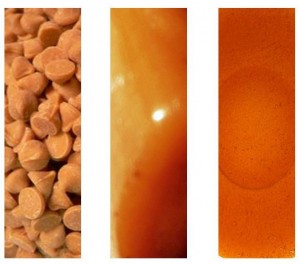The difference between caramel, butterscotch, and toffee
May 11, 2011
Here are three sugary solids that look similar - butterscotch, toffee, and caramel. It’s not too hard to tell them apart by taste and texture, but what are the actual differences in their manufacture?
All types of sugar candy are made from the same fundamental ingredient, a sugar/water syrup. The syrup is cooked, and as the temperature rises, the water boils off and the moisture content of the syrup decreases. The less water you have in the solution, the harder the resulting candy will generally be. For example, if you want to make hard candy or lollipops, you heat the solution to at least 300 degrees Fahrenheit before letting it cool. If, on the other hand, you want to make fudge, you heat it to only 230 degrees.
Check out the chart below, which is cribbed from Wikipedia (source), for all the details. Some of the stages have names, which describe what happens to the solution if you put a spoonful of it in cold water (the test that was used before candy thermometers were available).
| Stage | Temperature (°F) | Temperature (°C) | Sugar concentration |
|---|---|---|---|
| Thread | 230 - 233 °F | 110 - 111 °C | 80% |
| Soft Ball | 234 - 240 °F | 112 - 115 °C | 85% |
| Firm Ball | 244 - 248 °F | 118 - 120 °C | 87% |
| Hard Ball | 250 - 266 °F | 121 - 130 °C | 92% |
| Soft Crack | 270 - 290 °F | 132 - 143 °C | 95% |
| Hard Crack | 295 - 310 °F | 146 - 154 °C | 99% |
| Clear Liquid | 320 °F | 160 °C | 100% |
| Brown Liquid | 338 °F | 170 °C | 100% |
| Burnt Sugar | 350 °F | 177 °C | 100% |
You’ll notice that by 320 degrees Fahrenheit, all the water has boiled away, and what’s left is a pure solution of melted sugar. This is the beginning of caramel (apparently thought to be ultimately from Greek kanna, “sugar”, and melos, “honey”). As the sugar is cooked further, the caramel gets darker and darker until it burns.
So why doesn’t caramel just taste like a bunch of sugar? As the sugar gets heated, a bunch of delicious chemical reactions happen that create all sorts of interesting new molecules, which I’ll leave you to read about here. This also happens as you cook certain other foods as well, which is part of the reason why, for example, sauteeing vegetables can enhance their flavor dramatically.
So that’s caramel. By the way, caramel candy is made by taking the caramel, letting it cool, then mixing it with cream, sugar and vanilla. Or you can cook everything together and let the sugars in the milk caramelize instead of the added sugar, in which case you have a milk caramel.
What about toffee and butterscotch? Toffee is sugar heated to the hard crack stage, with lots of butter mixed in as well. Butterscotch is sugar heated to the soft crack stage, and you use brown sugar (sugar with molasses) instead of white sugar.
If you're on this page, I assume you're into great desserts. Check out this dessert cookbook from Brooklyn's Momofuku Milk Bar, featuring lots of really interesting stuff, including the "compost cookie".

Other Types of Candy
Here’s a chart explaining how a few other types of candy are made, as well, to give you a sense of what variations are possible on this process. You’ll notice corn syrup is in a lot of recipes in addition to normal sugar; because of its molecular structure it helps improve shine, smoothness and body.
Dulce de leche: Milk and sugar are simmered and stirred; water evaporates, and the sugars caramelize (though I can’t tell whether it’s the milk sugars that caramelize, the grantulated sugar, or both). A different browning reaction called the Maillard reaction takes place simultaneously; this is the same reaction that makes toast delicious.
Nougat: Water and sugar are heated to the soft ball stage, and whipped egg whites are added. To this is added a second solution of sugar, corn syrup, and often nuts, heated to the hard crack stage. Finally, add butter and vanilla. The mixture is left to cool in a pan.
Marshmallows: Water, sugar and corn syrup are heated to the soft ball stage. The hot syrup is added to a mixture of gelatin, water and vanilla extract, which is then whipped to incorporate air. The mixture is left to cool in a pan.
Peanut brittle: Water, sugar, corn syrup and peanuts are heated to the hard crack stage. The mixture is removed from the heat, butter and baking soda (for airyness) are added, and the mixture is poured into a pan to cool.
Taffy: Water, sugar, corn syrup and salt are heated to the hard ball stage. The mixture is removed from the heat, and butter, flavoring and color are added. As the mixture cools, it’s pulled to make it fluffy. The word “taffy” is a variant of “toffee”, which has an unknown etymology.
(Butterscotch chips photo from user mikefroese at sxc.hu, caramel photo posted by user Rainier Zenz at Wikimedia Commons)
